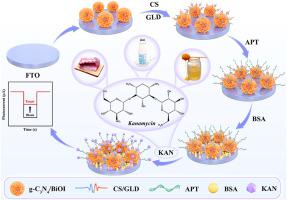当前位置:
X-MOL 学术
›
Anal. Chim. Acta
›
论文详情
Our official English website, www.x-mol.net, welcomes your feedback! (Note: you will need to create a separate account there.)
A novel photoelectrochemical aptasensor based on 3D flower-like g-C3N4/BiOI p-n heterojunction for the sensitive detection of kanamycin
Analytica Chimica Acta ( IF 5.7 ) Pub Date : 2024-06-12 , DOI: 10.1016/j.aca.2024.342867 Ziqian He , Dehua Su , Zhishan Liang , Zhifang Wu , Dongxue Han , Li Niu
Analytica Chimica Acta ( IF 5.7 ) Pub Date : 2024-06-12 , DOI: 10.1016/j.aca.2024.342867 Ziqian He , Dehua Su , Zhishan Liang , Zhifang Wu , Dongxue Han , Li Niu

|
Kanamycin (KAN) residues in animal-derived foods continuously enter the human body, which will pose serious threats to human health such as hearing loss, nephrotoxicity and other complications. Therefore, to sensitively detect KAN residues by a reliable technology is extremely urgent in food quality and safety. Compared with traditional methods being limited by cost and complexity, photoelectrochemical (PEC) biosensors benefit from some merits such as rapid response, excellent sensitivity and good stability. In this study, the construction of a highly efficient PEC platform to realize KAN residues detection is discussed. Herein, a novel p-n heterojunction consisting of flower-like BiOI microspheres and graphite carbon nitride (g-CN) nanoflakes was developed to establish a PEC aptasensor for KAN detection at 0 V. The prepared g-CN/BiOI heterostructure showed not only significantly enhanced PEC activity due to the larger specific surface area but also greatly increased charge separation efficiency owing to the strong internal electric field. Meanwhile, using g-CN/BiOI as a highly efficient photoactive material for binding amine-functionalized aptamers to capture KAN, the photocurrent signals showed a ‘turn off’ mode to achieve the sensitive detection of KAN. The proposed PEC aptasensor exhibited linear response for KAN from 5 × 10 to 3 × 10 mol L with a low detection limit of 1.31 × 10 mol L, and satisfactory recoveries (97.44–107.38 %) were obtained in real food samples analysis. This work presented a novel p-n heterojunction-based PEC aptasensor with strong selectivity and stability, rendering it allowed to detect KAN in animal-derived foods including milk, honey and pork. Additionally, the detection range satisfied the MRLs for KAN specified by the national standards, demonstrating the potential application for food analysis. The study provides a new insight into the development of efficient and practical biosensors for antibiotic residues detection.
中文翻译:

一种基于3D花状g-C3N4/BiOI p-n异质结的新型光电化学适体传感器,用于灵敏检测卡那霉素
动物源性食品中的卡那霉素(KAN)残留不断进入人体,会对人类健康造成听力损失、肾毒性等并发症等严重威胁。因此,通过可靠的技术灵敏地检测KAN残留对于食品质量和安全而言迫在眉睫。与受成本和复杂性限制的传统方法相比,光电化学(PEC)生物传感器具有响应快、灵敏度高、稳定性好等优点。本研究探讨了构建高效PEC平台来实现KAN残留检测。在此,开发了一种由花状 BiOI 微球和石墨氮化碳 (g-CN) 纳米片组成的新型 p-n 异质结,以建立用于 0 V 下 KAN 检测的 PEC 适体传感器。所制备的 g-CN/BiOI 异质结构不仅表现出显着增强的由于较大的比表面积,PEC 具有活性,但由于内部电场强,电荷分离效率也大大提高。同时,利用g-CN/BiOI作为高效光活性材料结合胺功能化适配体捕获KAN,光电流信号呈现“关闭”模式,实现了KAN的灵敏检测。所提出的PEC适体传感器对KAN在5×10至3×10mol·L的范围内表现出线性响应,检测限低至1.31×10mol·L,并且在实际食品样品分析中获得了令人满意的回收率(97.44-107.38%)。这项工作提出了一种新型的基于 p-n 异质结的 PEC 适体传感器,具有很强的选择性和稳定性,使其能够检测牛奶、蜂蜜和猪肉等动物源性食品中的 KAN。 此外,检测范围满足国家标准规定的KAN MRL,展示了其在食品分析中的潜在应用。该研究为开发高效实用的抗生素残留检测生物传感器提供了新的见解。
更新日期:2024-06-12
中文翻译:

一种基于3D花状g-C3N4/BiOI p-n异质结的新型光电化学适体传感器,用于灵敏检测卡那霉素
动物源性食品中的卡那霉素(KAN)残留不断进入人体,会对人类健康造成听力损失、肾毒性等并发症等严重威胁。因此,通过可靠的技术灵敏地检测KAN残留对于食品质量和安全而言迫在眉睫。与受成本和复杂性限制的传统方法相比,光电化学(PEC)生物传感器具有响应快、灵敏度高、稳定性好等优点。本研究探讨了构建高效PEC平台来实现KAN残留检测。在此,开发了一种由花状 BiOI 微球和石墨氮化碳 (g-CN) 纳米片组成的新型 p-n 异质结,以建立用于 0 V 下 KAN 检测的 PEC 适体传感器。所制备的 g-CN/BiOI 异质结构不仅表现出显着增强的由于较大的比表面积,PEC 具有活性,但由于内部电场强,电荷分离效率也大大提高。同时,利用g-CN/BiOI作为高效光活性材料结合胺功能化适配体捕获KAN,光电流信号呈现“关闭”模式,实现了KAN的灵敏检测。所提出的PEC适体传感器对KAN在5×10至3×10mol·L的范围内表现出线性响应,检测限低至1.31×10mol·L,并且在实际食品样品分析中获得了令人满意的回收率(97.44-107.38%)。这项工作提出了一种新型的基于 p-n 异质结的 PEC 适体传感器,具有很强的选择性和稳定性,使其能够检测牛奶、蜂蜜和猪肉等动物源性食品中的 KAN。 此外,检测范围满足国家标准规定的KAN MRL,展示了其在食品分析中的潜在应用。该研究为开发高效实用的抗生素残留检测生物传感器提供了新的见解。






































 京公网安备 11010802027423号
京公网安备 11010802027423号